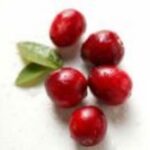It would be hard to find an evergreen ground cover that has as much to offer as the lingonberry, Vaccinium vitis-idaea. The fruits, beloved by all in Scandinavia, are born on low-growing, rapidly spreading plants with tiny oval leaves that stay green all year. Of course the berries can be made into lingonberry jam for your Swedish pancakes, but you can also turn them into juice, (they’re related to cranberries), add them to baked goods, or make yourself some lingonberry wine.
Some people make a potent concoction by soaking a quart of lingonberries in a quart of vodka for two months. The liquid is then poured off into a bottle, and the berries are mixed with half a quart of sugar. After the sugar and berries have been sitting for about a week, the sugar/berry mixture is then added to the liquid in the bottle. This liqueur is then aged about a month before drinking.
Lingonberries are easy to grow. Don’t hide these berry bushes in the vegetable garden – they are stunning year round, and make a nice low growing mat under flowering bushes or at the front of your flower beds.
In the wild, these plants grow in Northern Europe, in harsh, exposed habitats. For gardeners, that means that these plants will take little care, as long as they are given plenty of moisture until they’re well established. They will also much appreciate well-drained soils rich in organic mater. Like their relatives the cranberies, blueberries and rhododendron, they do prefer acidic soils with a pH between 4.5 to 5.5. Before planting, dig in some acidic peat moss instead of compost, since these plants do not like rich soil.
Lingonberries can tolerate some shade, especially if they are grown on the east side of your house, away from the hot afternoon sun. They do need some sun – at least 6 hours a day – to set a good crop of fruit. When planted 18 inches apart, the tall variety of lingonberry, var. vitis-idaea, will quickly fill in the understory of a mixed border, or near taller ornamental bushes or small trees. This variety will be about two feet tall when fully grown.
The smaller variety, var. minus, will only get eight inches tall, and should be planted about 10 inches apart if grown as a ground cover. They work especially well with other acid loving plants like hydrangea and azaleas. Mulching the plants with two inches of sawdust, wood chips or chopped straw will help the soil stay moist and will help the plants produce more fruit.
Lingonberries spread when new plants spring up on the dense mat of roots that grow just under the surface of the soil. Plants grown in full sun will branch more heavily and will have more flowers and fruit than plants grown in light shade. Plants grown in too much shade will still make a pretty ground cover, but they will not fruit as heavily. The plants are only somewhat self-fertile – you will get more fruit if you plant more than one variety.
If you have kids, be sure to buy a Lingonberry comb for picking the small fruits, and let the children have some fun while harvesting their own tasty, nutritious midsummer snack.




